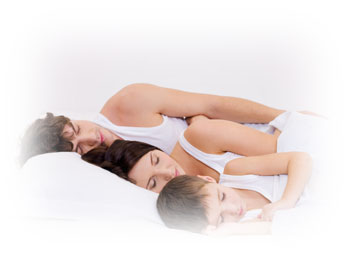Sleep Advice
Buying Guide

Decide your priorities in advance. For example is it price, storage, access to bedroom, turning the mattress, getting in and out of bed, overall size or maybe a health issue. Buy for correct support and comfort for your weight and build not just firmness.
Check dimensions. Remember bed frames are not standard sizes and are wider and longer than mattress sizes. Also think BIG. Larger beds are more comfortable. Being disturbed by a sleeping partner is one of the most common complaints relating to poor sleep.
Wear loose clothing to feel comfortable. Be prepared to lie down and try as many beds as is necessary. Lie in your normal sleeping position move around a bit take a few minuets on each model to check comfort.
If the bed is for two people, please lie on it together to check how support and comfort react.
Ask us as many questions as you wish, that’s what we are here for.
Above all, take it seriously, spend as much time as possible, a bed is the most used item in your home. This year alone you will sleep for 15 whole weeks.
A good bed is a mattress and base working together, don’t consider them in isolation. Please check condition of your base.
All mattresses are approximate sizes, with differing tolerances. A new mattress may not fit existing bases exactly.
Is access into your house and bedroom sufficient? Particularly stairwells and staircases.
Just in case of unforeseen circumstances do not dispose of your old bed until new one arrives.
Useful links
- The Sleep Council Bed Advice
- The London Sleep Centre - A leader in treatment for people with sleeping disorders
- Asthma UK
- Back Pain
- British Osteopathic Association
Caring for you and your new bed

Many thanks for choosing us for your new bed/mattress. We hope it will enhance your comfort and improve your sleep, for many years to come.
Please read our following information and the accompanying care leaflet supplied with your purchase from the manufacturer.
Proper assembly and installation
Please ensure your new bed is installed and assembled properly. If not damage can occur which will impair the durability and comfort.
Bed frames, bunks and childrens beds are self assembly. These beds have unique fixings and will be found in the packaging along with the assembly instructions.
Airing a new bed or mattress
Allow the mattress to breathe for about 4 hours before fitting your bedding. This will allow moisture which may have been trapped by the packaging to evaporate.
You will notice an aroma of newness, this is normal and will soon fade away, if aired regularly.
Mattresses
Your new mattress may have shrunk in length a little due to transport and storage.
Once you start sleeping on it, it will spread out to its correct length. This is more common with mattresses that have pocketed springs.
Body conformity
This is normal in a quality mattress. Mattresses are designed to conform to the contours of your body, allowing you a comfortable, healthy nights sleep. This will take place over the first few weeks of use.
If you notice impressions do not worry, it is conforming to you like a new pair of shoes, it will break in and become more comfortable.
Settlement of fillings
Today’s mattresses are skilfully made and are generously upholstered with quality fillings. This upholstery takes a little time to settle, longer in high quality beds.
The upholstery settles first in the most common sleeping position, but progressively the settlement takes place over the whole sleeping surface, this is a natural process and no cause for concern.
Turning

To ensure your mattress life is maximised, turn your mattress regularly, both end over and side to side. This should be done every 2 weeks for the first 6 months and at monthly intervals thereafter.
Cushioning and insulation materials will be properly and evenly distributed. This is vital to restore a mattress especially during the first few months.
Memory foam, latex mattresses and any no turn mattresses should be rotated from head to foot to even wear on the sleeping surface. Indentation of up to 20mm is completely normal.
Protect your mattress
No mattress is completely colourfast.
We highly recommend you use a waterproof protector. Today’s protectors have a special membrane which does not make them hot to sleep on. This will protect against accidental soiling from body moisture or other liquids. It also protects against dust mites and possible damage to cover and fillings. Importantly it also helps safeguard your guarantee/warranty.
Discolouration of fillings
This can be caused by a chemical reaction that occurs during normal use.
Chemicals are used in fire retardants and in the process of foam and latex productions. If these chemicals come into contact with deodorants, detergents or even perspiration discolouration can occur. This is completely harmless and does not effect the performance of the mattress.
Dos
- Air the mattress regularly
- In the morning turn back the bed clothes and leave the bed to air for 20 minutes to allow body moisture to evaporate
- This helps prevent body moisture reacting with fabric dyes
- Use a soft brush periodically to clear dust and fluff. Never vacuum in case of fillings being disturbed
Don’ts
- Bend or fold, this is likely to damage the spring unit and will invalidate any guarantee
- Move your bed by the headboard - this may cause damage to the bed frame and headboard and therefore invalidate your guarantee
- Remove fire label
- Sit on the edge of your bed for long periods
- Use chemical or detergent cleaners on a stained mattress - instead lightly sponge with a weak solution of soap and water
- Wet excessively as fabric could be damaged




